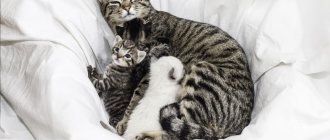Origin, description and appearance (color)
The Thai cat, the first mention of which dates back to the 14th century, was considered a symbol of success and financial well-being in Siam. This breed of cat could be seen in the homes of the richest and most noble families.
The cat was a permanent resident of Buddhist temples and was present at all rituals. Since the borders of the Siamese state, now Thailand, were closed for a long time, the Thai breed was first brought to Europe only in the 19th century.
The Thai cat, the first mention of which dates back to the 14th century, was considered a symbol of success and financial well-being in Siam
As a result of the work of breeders, the breed acquired new features - a wedge-shaped head, elongated ears and thin legs and paws. The resulting new breed became known as the Siamese.
American breeders took the path of preserving the original characteristics of the Thai breed. Work has been carried out since the 19th century, but only in 1990 was the breed standard adopted and its official status secured.
Interesting . The purebred Thai breed is considered rare. In order for a domestic cat with signs of a given breed to acquire the official status of belonging to it, it is necessary to undergo a series of special tests and receive at least two positive expert opinions.
Nowadays, the exterior of the Thai cat is most similar to what it was 7 centuries ago.
It has the following characteristics:
- The head is round, resembles the shape of an apple, has no angularities or sharp features
- The muzzle is of medium length with clearly defined cheeks in adult cats. The transition from nose to forehead is smooth, at eye level. The chin is strong, the nose is straight and of medium length.
- Ears with rounded tips, set wide apart and slightly set apart. An imaginary line from the tips of the ears to the nose forms a right triangle.
- Apricot kernel shaped eyes. Eye color ranges from bright azure to sapphire blue.
- The neck is of medium length, strong, muscular.
- The body is dense, sinewy, the chest is wide.
- The limbs are of medium height with round paws.
- The tail is wide at the base, tapering towards the end.
- The coat is silky with a moderately developed undercoat.
The Thai cat is very curious, loves to do all interesting things together with its owner, considers itself a full-fledged member of the family.
The calling card of the Thai cat is the color point color. The body is light, the limbs, tail, as well as the muzzle and ears are dark. The most common color of the seal point is cream tones of the coat and brown shades of the limbs and muzzle. There are also colors of red, bluish, light tones, including ivory.
Interesting . Kittens get their famous coloring gradually. First, the nose and contours of the ears darken. They are born completely white. Full color appears in the first year of life.
The tabby point color looks very impressive when the markings on the cat’s body appear in distinct stripes. Their shade can be varied.
Brief description of the breed
The breed is relatively new. Its standards were approved in Germany in 1990. The animal is independent and active, gets along well with children.
Description of the breed:
- Proportional body.
- Flexible body.
- The weight of females is up to 4 kg, males – up to 6 kg.
- The head is teardrop-shaped.
- The muzzle is of medium length and has rounded outlines.
- The nose is of medium length, straight.
- The ears are set wide apart and spread to the sides.
- The eyes are shaped like apricot kernels and their color varies from bright azure to blue.
- The tail is wide at the base, tapers towards the tip, and is of medium length.
- The chest is wide.
- The neck is of medium length, strong.
- The legs are muscular.
- The coat is thin, short, and has an undercoat.
- There are dark markings on the bridge of the nose, at the ends of the paws and on the tail.
Thai cats resemble Siamese cats. The difference is in a more massive body and grace. On average, Thai cats live 10-14 years . There are known representatives of the breed who lived up to 28 years.
By nature, cats are flexible, inquisitive, active, and affectionate. They are easy to train to follow certain commands. Thai representatives are good mouse catchers.
Breed character and habits
Thai cats are endowed with great intelligence and an aristocratic character. They are very curious and attached to their owner. If it is absent for a long time, the animal may begin to refuse food and get sick.
Interesting . Thai cats easily endure moving and traveling because they become attached not to a place of residence, but to a person.
Thanks to their high intelligence, they easily learn and master various tricks, for example, they can throw objects with their front paws. Trainable.
Be sure to read:
The Egyptian Mau is a short-haired cat breed with a spotted coat and an outgoing personality.
The Thai cat is an active animal. She needs very little time to sleep, so you rarely catch Thais doing this activity
They have a lively disposition, love to jump and climb, especially at heights - on cabinets and shelves. Thai cats are very clean.
They can spend long hours playing with children. Do not come into conflict with other pets. Other members of the cat's family enjoy authority, but most of all she loves to spend time alone with her owner.
Aggressive behavior is not typical for Thai cats. Sometimes manifestations of aggression can be found in non-purebred pets, mestizos. Purebred cats do not have such genes, so their character is gentle and friendly.
Maintenance and care
Cats of this breed do not need specific care, despite their aristocratic origin.
It will be enough to purchase the necessary accessories for a comfortable life for your pet - a litter tray, containers for food and water, and a scratching post.
In everyday life, it is important to take into account the pet’s excessive activity and not leave fragile objects on cabinets. Mosquito nets on windows must fit well in the slots to prevent the animal from falling.
Diet and feeding
The Thai cat's diet is based on foods high in protein.
Meat, preferably dietary (turkey fillet, rabbit, chicken breast), should make up half of the daily nutritional ration. You can give boiled pork, chicken backs, necks, heads, boiled river fish.
Aggressive behavior is not typical for Thai cats
Important. It is better not to overfeed with sea fish and seafood. The iodine they contain changes the shade of the coat, which is very important for show breeds.
Low-fat cottage cheese and fermented milk products are beneficial for cats. You should not give milk in its pure form - it can cause digestive problems.
Cereals are an important component of the diet. If your cat refuses to eat porridge in its pure form, you can use a blender and mix it with the meat.
The Thai cat's diet is based on foods high in protein.
Forbidden for a Thai cat are liver and coloring vegetables such as carrots and beets. After eating them, darkened areas may appear on the fur, spoiling the appearance of the animal.
Feeding any sweets is prohibited - the alkaloids they contain can kill the animal.
At the same time, it is necessary to ensure that the cat always has drinking water in the quantities it needs.
Important. When choosing dry food, preference is given to the super-premium or holistic class. You need to pay attention to food for cats with white or pointing colors: they do not contain components that affect the color of the coat.
Hygiene
Thais' fur does not tangle, but the animal needs to be brushed periodically with a rubber brush to remove dead hair.
Do this in the direction from head to tail. After combing, run a damp cloth through the fur to collect the remaining hairs. To make the wool shiny, you can polish it with suede or silk fabric.
Thais' fur does not tangle, but the animal needs to be brushed periodically with a rubber brush
Bathing is allowed only before the exhibition or if the cat is very dirty in the mud. For this, a special zoo shampoo is used. Frequent water treatments are harmful to the coat.
Important. Periodic discharge of tear fluid from the eyes is normal. Tear marks formed on the cheeks near the nose are removed with a linen napkin.
Once every two months, it is necessary to remove the wax deposits that have formed inside the cat’s ears. This is done with a piece of cloth soaked in vegetable oil. Only the inner surface is cleaned, the ear canal is not affected. For deep cleaning, special drops intended for animals are used.
Be sure to read:
Oriental cats - Oriental Shorthair cat, description of the breed, care and prices
Once every two months, it is necessary to remove the formed wax deposits inside the cat’s ears.
It is also important to carry out timely prevention of parasites and disease prevention. Periodic examinations with a veterinarian will help with this.
Training and education
A kitten needs to be trained from childhood; at this age it is more amenable to education. As an adult, it is much more difficult to instill certain habits in a cat.
It is important to respect the cause-and-effect relationship. For example, when a kitten begins to shit in the wrong place, it should be scolded immediately after the offense. He sincerely will not understand why they are poking him in the puddle and scolding him when an hour has already passed since the moment he did it.
At the same time, it is important not to forget about praise. For example, praising the kitten when he went to the litter box so that he understands that he did the right thing.
A kitten needs to be trained from childhood; at this age it is better able to be raised
A Thai cat can easily master commands such as “Come to me”, “Sit”, “Lie down”, “No” and, with the help of training, perform complex tricks.
Life expectancy and typical diseases
Thai cats are on the list of longest-living felines.
Their average life expectancy reaches 16-18 years.
With proper care, the absence of stressful situations and timely vaccination, the life of a cat can reach 25-28 years. There are cases where pets of this breed have reached their thirties.
Even despite their strong immunity, natural strength and strong body, these cats are susceptible to breed diseases:
- lungs' cancer,
- heart disease,
- diabetes,
- liver diseases.
If your cat has excessive salivation or vomiting or refuses to eat, you should consult a doctor immediately.
Thai cats are included in the list of longest-living felines.
Specific diseases of Thai cats are squint and tail defects. Both of these traits are hereditary.
A kitten's strabismus may be temporary. In an adult cat, it can develop after suffering stress.
Lumps and curvatures in the tail were once considered breed characteristics, but nowadays only a straight tail is recognized.
Castration and sterilization
The optimal age for sterilization is 6-10 months. The idea that a cat needs to give birth at least once is a myth. If you do not plan to use the cat for further breeding, sterilization is the best option for its health.
The optimal age for sterilization is 6-10 months
Castration of a cat can be done at home. The operation must be performed by an experienced surgeon.
In the first two weeks after surgery, it is necessary to provide the animals with decent care. It is necessary to treat the sutures and give medications prescribed by the doctor on time.
Breeding
When breeding Thai cats, it is important to choose the right partner for your pet.
Mating and partner selection
Before mating, the male and female cats must be one year old; allowing them to mate earlier is unacceptable, as there is a risk of getting weak, sick offspring.
Interesting. Puberty in Thais occurs at the age of 4-5 months - earlier than in other breeds. But it is categorically not recommended to allow animals to mate at this age - this risks a long, protracted labor for the cat, and an early loss of fertility for the cat.
Mating should take place on the male’s territory – this way he feels more confident. Before mating, animals are treated for fleas and worms and their nails are trimmed so that they do not accidentally injure each other.
The cat is left with the cat for 3-5 days. There is no point in leaving a cat for more than five days, as she may begin to miss her owner, and then mating is out of the question.
Be sure to read:
Cats that look like a leopard: cats with brindle and leopard coats
A cat's pregnancy usually lasts about 9 weeks.
Pregnancy and childbirth
If four weeks after mating the cat has not gone into heat, then she has succeeded in becoming pregnant. If estrus begins, repeated mating is carried out.
Pregnancy and childbirth in Thai cats usually proceed without complications , but if you are about to give birth for the first time, you may need the help of the owner.
A cat's pregnancy usually lasts about 9 weeks. Childbirth occurring before the 58th day from conception is already considered a pathology. The offspring is born prematurely and may die.
It is considered normal if pregnancy lasts for one week. However, if the cat does not calve at the required time, veterinarian intervention is necessary to preserve the offspring.
Where to buy a Thai cat kitten?
There are plenty of nurseries in Russia that breed Thai cats. However, people who want to breed Thai cats or purchase a high-class kitten for exhibition activities may be interested in the offers of foreign catteries. When choosing a show-class kitten, it is advisable to seek the help of a specialist who understands the breed, otherwise there is a risk of deception.
It is worth noting that many nurseries (both Russian and foreign) provide delivery services. Before purchasing, it is recommended to check the reputation of the chosen nursery. When you decide to buy a Thai kitten, it is advisable to make a reservation or negotiate with the breeder in advance. You should know that Thai kittens are born completely white and only after a few weeks do they begin to develop points (color).
Characteristics of this breed
The Thai cat is not a hypoallergenic breed, so before purchasing an animal it is advisable to make sure there are no allergies.
When breeding Thai cats, it is important to choose the right partner for your pet.
Shedding
Shedding in cats can be caused by a number of factors:
- Seasonal changes. In this case, hair loss is normal.
- Cats being in a stressful situation. In this case, the wool may fall off in clumps.
- Lack of essential minerals in the body, poor nutrition.
- Hormonal disorders. Neutered cats and female cats can become completely bald.
- The presence of parasites in the fur.
It is important to control the molting process and carry out combing in a timely manner. If your pet does not stop shedding for more than a month, you need to contact your veterinarian to find out the reasons.
Allergy
It is not necessarily furry pets that cause allergies. The cause of the reaction is a specific protein that is contained in the saliva of cats of different breeds, including Thai.
Interesting. To some extent, ventilation and frequent wet cleaning of the room will reduce the allergic reaction. However, they cannot give the full effect.
Cost of a Thai breed kitten
On average, according to statistics, a Thai cat costs from 5,000 to 25,000 rubles. Until the age of 12-18 weeks, a Thai kitten should live near its mother. The Thai mother cat feeds and cares for the cub, providing it with everything necessary for full growth and development. While staying near its mother, a small animal learns many independent living skills - nutrition, toileting, play elements, hygiene procedures, and so on.
© shutterstock
The price of a kitten of the Thai breed is classified as follows::
- a kitten without a pedigree will cost from 1000 to 3000 rubles;
- a kitten that does not have documents, but comes from purebred parents, will cost the buyer from 3,000 to 5,000 rubles;
- the presence of metrics, an impeccable exterior and a recorded pedigree increase the cost level of a representative of the Thai breed several times - from 10,000 to 25,000 rubles.
While the pet is in the kennel, he receives the first mandatory vaccinations. Animals that are one year old can undergo spay or neuter surgery. An adult Thai cat is a good option for purchasing, as it can be immediately taken to a new home, where it can easily and quickly adapt.
Where to buy and how much does a kitten cost?
The origin of the kitten must be confirmed by relevant documents.
You can buy a Thai in breed nurseries , which are located in every major city. In this case, you can be confident in the breed qualities of the kitten. The purchase will cost approximately $500-700.
The second option is to purchase a kitten without documents, whose parents are classified as a breed and have official confirmation. It will cost $300-400 less.
The third option is the riskiest - buying a kitten on the market without documents . In this case, you may end up with a crossbreed or even an outbred animal.
The price of a kitten may vary depending on the reputation of the nursery, the color of the pet, and the presence of distinctive and rare breed characteristics. What should you pay attention to?
When choosing a kitten, you need to carefully examine:
- Color (it should be uniform) and quality of coat (no bald spots).
- Eyes and ears: no purulent discharge.
- General body structure: no injuries, no congenital defects.
- Behavior: active.
It is also important to obtain information about diseases suffered by the kitten’s parents, surgical operations, and vaccinations.
The origin of the kitten must be confirmed by relevant documents.
What determines the cost of a Thai cat?
The price for kittens of the Thai breed depends on many factors - age and pedigree, achievements and marks at exhibitions and championships, gender and appearance, availability of vaccination and quality of kitten care, level, fame and location of the nursery, relative to Moscow.
Only those cats that have an official certificate are considered true carriers of the Thai breed. All others are considered only superficially similar to this breed.
Table: pros and cons of the breed
Thais have their advantages and disadvantages:
| pros | Minuses |
| Affectionate, gentle | Do not tolerate loneliness well |
| Playful, quick to learn | They like to throw flower pots and vases off windows and cabinets. |
| Picky eaters | Liver, carrots, beets and iodine-containing foods should not be given to avoid changes in coat color. |
| Have strong immunity | There are breed diseases |
| Smart, emotional | Not a hypoallergenic breed |
The Thai cat is an active and intelligent pet that requires attention from its owner. Particular attention should be paid to Thai nutrition and health. Then the animal will live in the family for many years.











